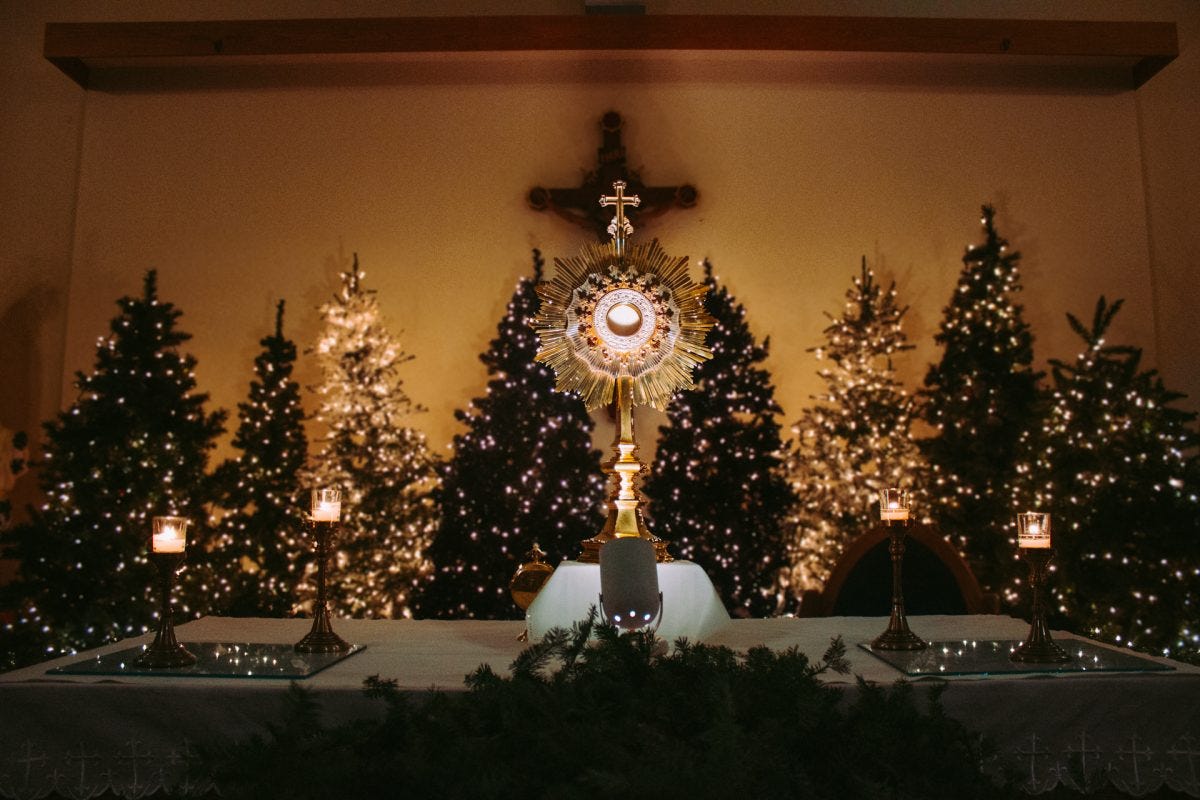Just as we should always be mindful to keep Christ in Christmas, I think it is equally important to understand the connection between the Mass and Christmas.
“She wrapped him in swaddling clothes and laid him in a manger, because there was no room for them in the inn.” Luke 2:7
We are so familiar with this verse. It is recited and reenacted over and over this time of year. Despite the familiarity, I find that I am constantly brought back to it, to learn and ponder more deeply the meaning of the words in this one short sentence. Did you know that the swaddling cloths in Jewish tradition were used to wrap around the spotless lambs chosen for sacrifice in the temple, or that the word “manger” referred to the animal feeding trough? The word καταλύματι is often mistranslated in this verse to “inn”, but it is better understood as “guestroom”. This Greek word is found one other place in the New Testament, in Luke 22:11. In this verse καταλύματι is used in reference to “the upper room”, or “guest room”, where Jesus and His apostles will celebrate the Passover, the Last Supper, and the institution of the Eucharist.
The symbolism and foreshadowing within the Nativity account is numerous. In celebrating the Mass, we remember the birth of Christ each and every week. On Sundays, solemnities, and feasts we sing the Gloria during the Introductory Rite. We join and echo the choir of angels that appeared to the shepherds on Christmas night, “Glory to God in the highest and on earth peace,” Luke 2:14.
Christmas is the Word of God made flesh. It is the moment our God became human, as an infant completely reliant on Mary. Caryll Houselander puts in in perfect poetry in her classic work The Reed of God:
He was completely her own… She was the shrine of the Sacrament, the four walls and the roof of His home…
In giving life to Him she was giving Him death…
That is what it meant to Mary to give human nature to God. He was invulnerable; He asked her for a body to be wounded. He was joy itself; He asked her to give Him tears. He was God: He asked her to make Him man. He asked for hands and feet to be nailed. He asked for flesh to be scourged. He asked for blood to be shed. He asked for a heart to be broken. The table at Bethlehem was the first Calvary. The wooden manger was the first Cross. The swaddling bands were the first burial bands. The Pass had begun. Christ was man.
Jesus took on flesh so that He could become the sacrificial lamb, to save humanity from our sins. He then gave us His flesh and blood in the Eucharist so we may live with Christ in us. Jesus tells us, “I am the bread of life. Your ancestors ate the manna in the desert, but they died; this is the bread that comes down from heaven so that one may eat it and not die. I am the living bread that came down from heaven; whoever eats this bread will live forever; and the bread that I will give is my flesh for the life of the world.” in John 6:48-51. This teaching was difficult said His disciples. Jesus continues, “Amen, amen, I say to you, unless you eat the flesh of the Son of Man and drink his blood, you do not have life within you. Whoever eats my flesh and drinks my blood has eternal life, and I will raise him on the last day. For my flesh is true food, and my blood is true drink. Whoever eats my flesh and drinks my blood remains in me and I in him.” After hearing this many disciples left Jesus and returned to their former lives. He wouldn’t let them walk away if He had been speaking metaphorically or symbolically. It’s no coincidence the word Bethlehem means house of bread and lambs for Passover sacrifice at the Temple were chosen from herds raised only in Bethlehem.
When we celebrate the Mass, we return to the Nativity, the incarnate Lord, lying in a manger in Bethlehem. In the Eucharist, we are united as one with our Savior.




